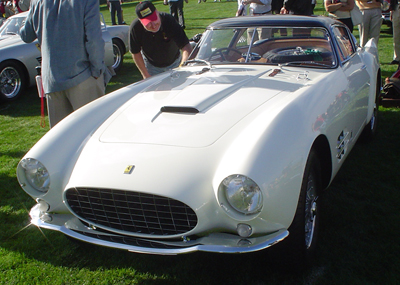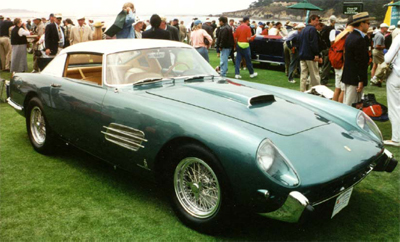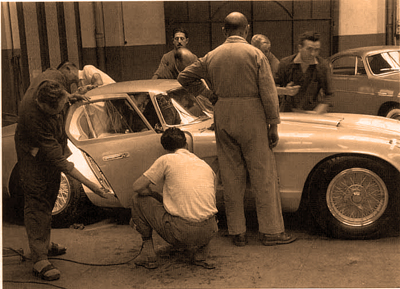|

"Cars with styling that differentiates them most from the designs
of their production cousins will generally be more valuable than
those with only slight deviations from the norm."
Throughout the 1950s and well
into the 1960s, various Italian carrozzerie chose to
showcase their talents to the world by creating one-of-a-kind
works of automotive fantasy on Ferrari chassis. In addition
to these extraordinary automobiles, a number of Ferraris were
commissioned by royal and otherwise powerful clients and received
unique coachwork at their request.
Today, a one-off 250 GT or 410
Superamerica is, without question, valued well above one of its
more ordinary road-going cousins and, in some cases, custom
coachwork cars such as these have sold for as much as ten times
the market value of the standard car. The question, then,
is: How does one place a value on such a unique automobile?
BASE
VALUE
Several factors determine the premium that a speciale will
bring. The first of these is the value of a standard car of
the same type and condition. While a one-off based on a PF
Coupe might sell for ten times the price of a production PF, the
same will not be true for more valuable models. As an
example, 250 GT s/n 0725GT, a one-off coupe built in 1957 for
Prince Bernhard of the Netherlands, changed hands in May of
1999 for approximately $1.2 million dollars. At that time,
"excellent condition" production 250 GTs, with standard bodies by
coachbuilder Ellena, were selling in the $100,000 -
$125,000 range.
By comparison, a decent 410 Superamerica would have brought
somewhere around $400,000 at that time but, by no means, would any
of the one-off SAs have been worth anything close to $4 million.
In fact, a few years later, when "run-of-the-mill" 410 SAs were
fetching upwards of $600,000, the uniquely bodied (and named) 410
SA, branded by Pinin Farina as "4.9 Superfast" (s/n 0719SA), was
purchased by the same collector who had bought the Prince Bernhard
250 in 1999 (and from the same seller, no less) for something like
$1.9 million.
 PROVENANCE PROVENANCE
As with any vintage
Ferrari, provenance can substantially influence the market value
of a coach-built speciale. I asked two prominent
market experts their opinions on the value of the ex-Princess
Lilliane de Rethy 330 GTC Speciale, s/n 09439, and its twin
sister, s/n 09653, which was first owned by pioneer heart surgeon,
Michael E. DeBakey. Oddly, they had widely varying opinions
on the value of the de Rethy car, but were in complete
agreement on one thing: The royal history of 09439 insured that it
would always be more valuable than its sister car.
AESTHETICS
The factor that has the
greatest influence on a one-off's value is also the most difficult
to find agreement on, beauty being in the eye of the beholder and
all that. Personal tastes aside, though, there is one
aesthetic rule that seems to hold true most of the time:
Cars with styling that
differentiates them most from the designs of their production
cousins will generally be more valuable than those with only
slight deviations from the norm. Sticking to our 330 GTC
example cited above, in addition to four similarly styled "de
Rethy" GTCs, Pininfarina endowed 330 GTC s/n 09571 with a "de
Rethy" style nose treatment. With the exception of unique
door handles and a full-width rear bumper, however, the rest of
the car's exterior was standard GTC faire. Everything else
being equal (condition, provenance, etc.), odds are that 09571
could never be the financial equal of its more exotic relatives.
 Here's
another example using three special-bodied 410 Superamericas for
comparison: 0483SA, 0671SA and 0719SA: Here's
another example using three special-bodied 410 Superamericas for
comparison: 0483SA, 0671SA and 0719SA:
As mentioned above, 0719SA sold a
few years ago for approximately $1.9 million. By comparison,
0483SA (called "Superfast" by Pinin Farina) changed hands recently
for a reported $3 million. Why such a large difference?
Well, it's true that the market has been moving upward, but there
were a couple of other factors at play as well. 0483SA was a
ground-breaking vehicle for Ferrari. While it made its debut
in the same year as the first series production 410 SAs, it's
styling was very futuristic, predicted the overall shape of the
later Series III SAs and, in retrospect, set the tone for
Pininfarina designed Ferraris throughout the second half of the
1950s and into the early 1960s (with the exception of its
prominent tail fins, of course).
0719SA, on the other hand, appeared
near the end of Series II production and all-to-closely resembled
the Series III cars that would soon follow. While stunning
at the time, its design was mostly a cleaned-up version of the
original "Superfast" and, today, does not distinguish itself
enough from "standard" Series III Superamericas - a classic
example of the "more unique = more valuable" factor.
The third 410 Superamerica in
this example, however, complicates things a bit. 0671SA is,
without a doubt, the most uniquely designed of all of the SAs.
The only Superamerica bodied by Scaglietti, it sports such
oddities as a stainless steel roof and tail fins. While I
personally find this car's design to be highly desirable, it
seems that not everyone agrees with my eclectic tastes. I've heard
more than a few folks comment on its "hideousness" and/or snicker
at its unusual stainless add-ons. I would guess that this
car should be going to a new owner soon and it will be interesting
to see which of these factors weighs in the heaviest, or if it's
even possible to tell, with the car's condition and the accuracy
of its restoration also likely to play a role.
 FURTHER
COMPLICATIONS FURTHER
COMPLICATIONS
Up to this point, we've
dealt with custom-bodied specials built on production road car
chassis. Even though it may not always be easy to determine
what premium these cars deserve over their more regular brethren,
at least it's obvious that they will be worth more when offered
for sale. When it comes to coach built speciale based
on competition chassis, however, the lines are drawn and
everyone's not standing on the same side.
Again, I questioned the same two
market experts on this topic and was surprised to find them so
divided in opinion. As examples, I provided them with the
chassis numbers of three such cars and asked how they would value
each. All three were built on modified 375 Mille Miglia
chassis, two as show cars and the third for a royal customer,
fitted with 375 Plus engine. All are "solidly" owned by
collectors and are not likely to come to market anytime soon.
"$10 million. $10 million. $10
million," was the first expert's answer. "I know that two
very prominent collectors have offered substantial money to the
owners of these cars and the owners wouldn't sell!"
Expert number two disagrees.
"Hummnnn. I can see $5 million for each, but I sure as Hell
cannot see $10 million, as coach-built cars have never been worth
anywhere near as much as competition cars."
He explains, "A one-off show car is
good for one show at Pebble Beach, then you drag it around for a
year or so and do Cavallino, the Nationals and whatever else turns
your crank. Then what? A comp car can be used on the street,
or at almost any venue, and you can take your buddy/partner/lady
friend for a ride. Hence, competition cars have ALWAYS been
far more valuable than coach-built cars!"
Our first expert responds, "These
cars compete with the competition cars market-wise because
one-offs with custom coachwork are clearly the trend for the
future. Everybody wants something unique and not the
ordinary 375 MM racing spyder with Pinin Farina bodywork!"
|

